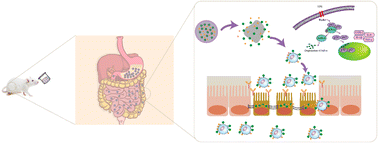The synergistic effect of epigallocatechin-3-gallate and quercetin co-loaded hydrogel beads on inflammatory bowel disease
Abstract
The synergistic effect of epigallocatechin-3-gallate (E) and quercetin (Q) enhances the therapeutic efficacy on related diseases; however, the instability and lower bioavailability of E and Q limited their application. Therefore, E and Q were co-encapsulated in hydrogel beads (H) with sodium alginate (SA) and soybean protein isolate (SPI) to improve their stability and bioavailability. The anti-inflammatory effect and molecular mechanism of action of E and Q co-loaded H in inflammatory bowel disease (IBD) were also investigated. The results showed that EQH-treated macrophages produced the lowest NO and TNF-α at 18.64 μmol L−1 and 5855.25 ng mL−1, respectively. The protein expression of p-NF κB-p65 was the lowest in EQH, indicating that EQH inhibits the activation of the pro-inflammatory NF-κB signaling pathway. The colon length of IBD model rats fed EH, QH, and EQH increased; histological analysis revealed intact layers of colonic epithelial cells with no observable tissue damage. The TNF-α and IL-1β levels in the plasma of the EQH-treated rats decreased, indicating the inhibition of the TLR4 and NF-κB signaling pathways, and Q's level in the colon was the highest at 0.04 mg mL−1. This study provides a theoretical basis for the application of E and Q in IBD.



 Please wait while we load your content...
Please wait while we load your content...